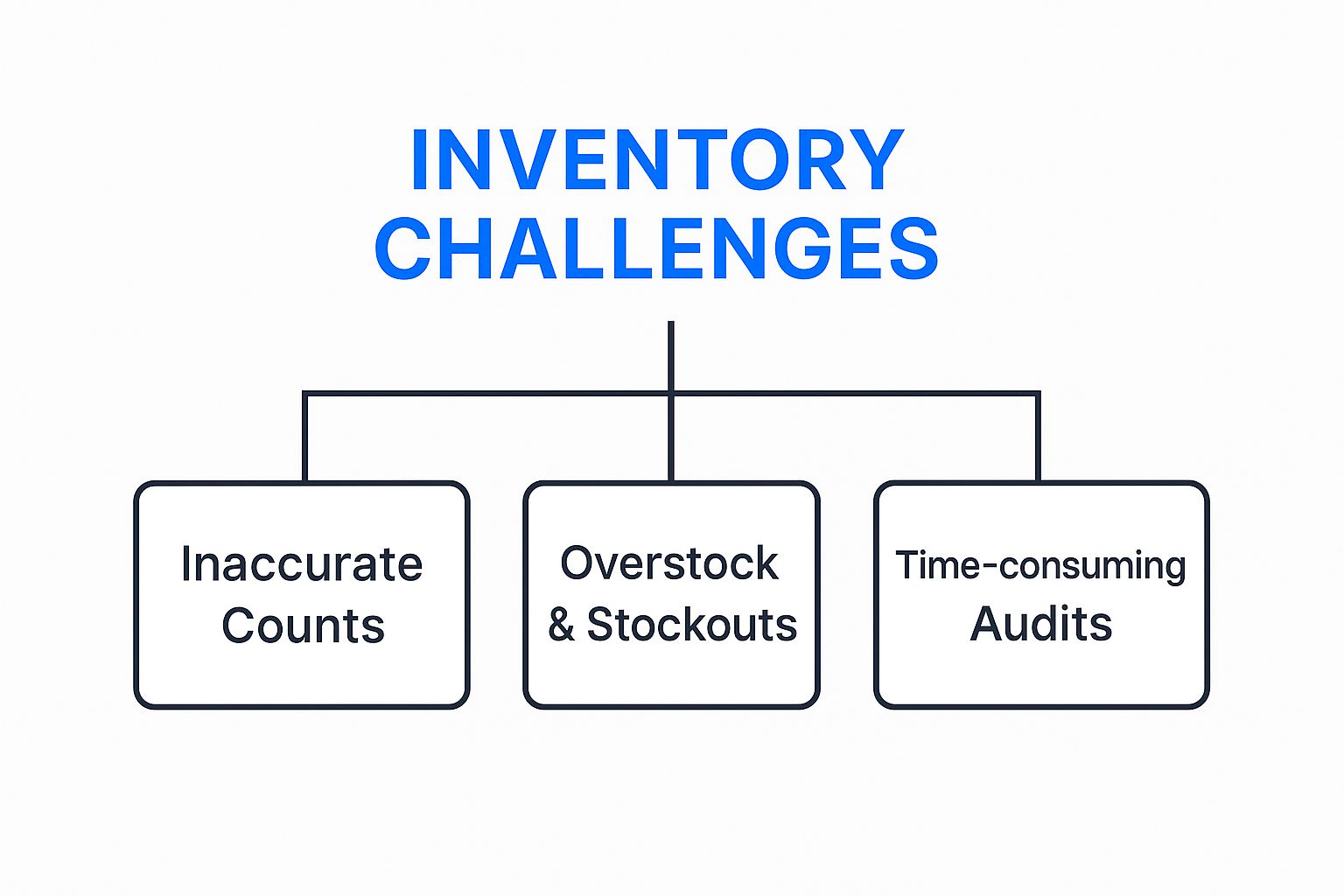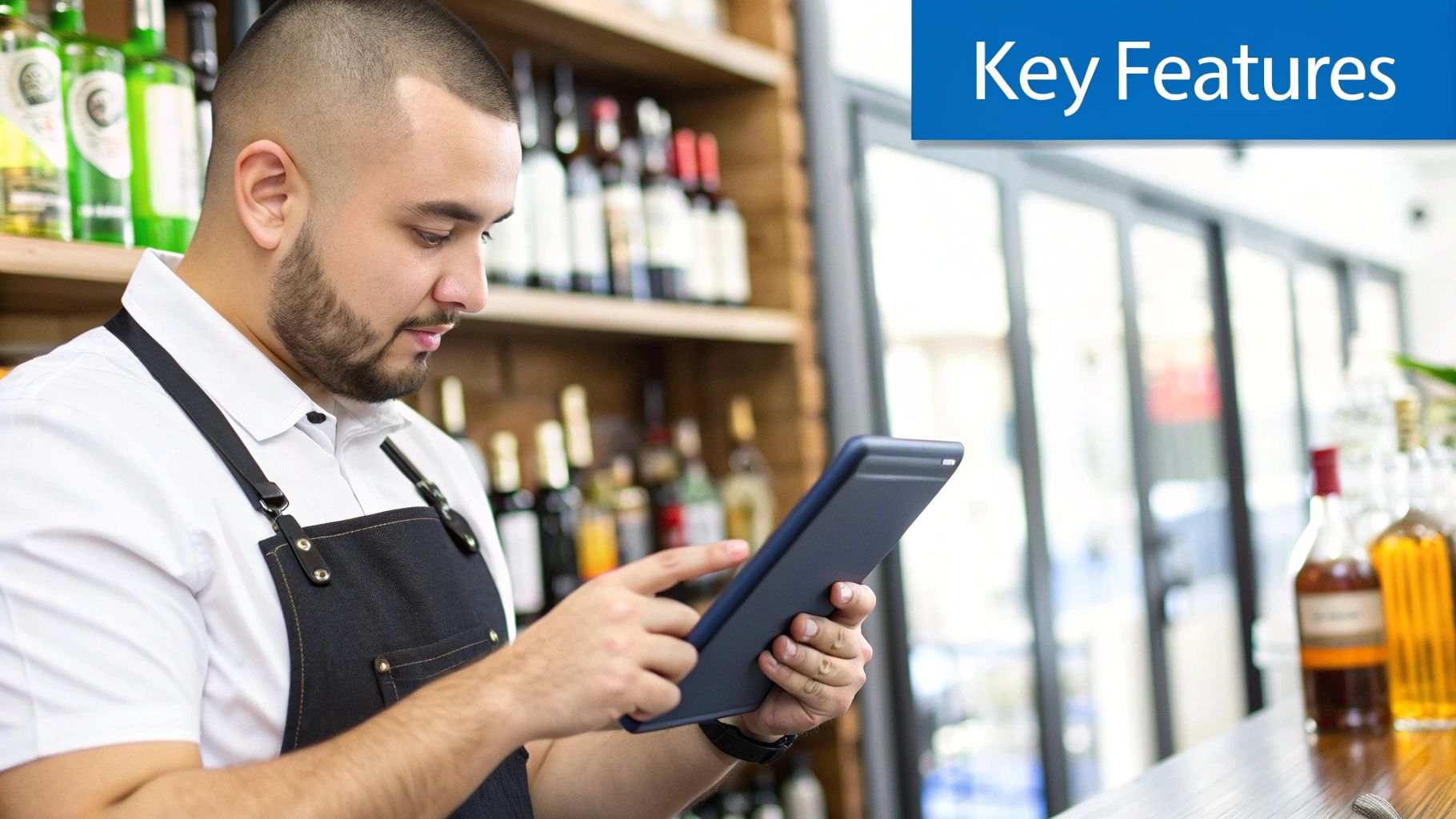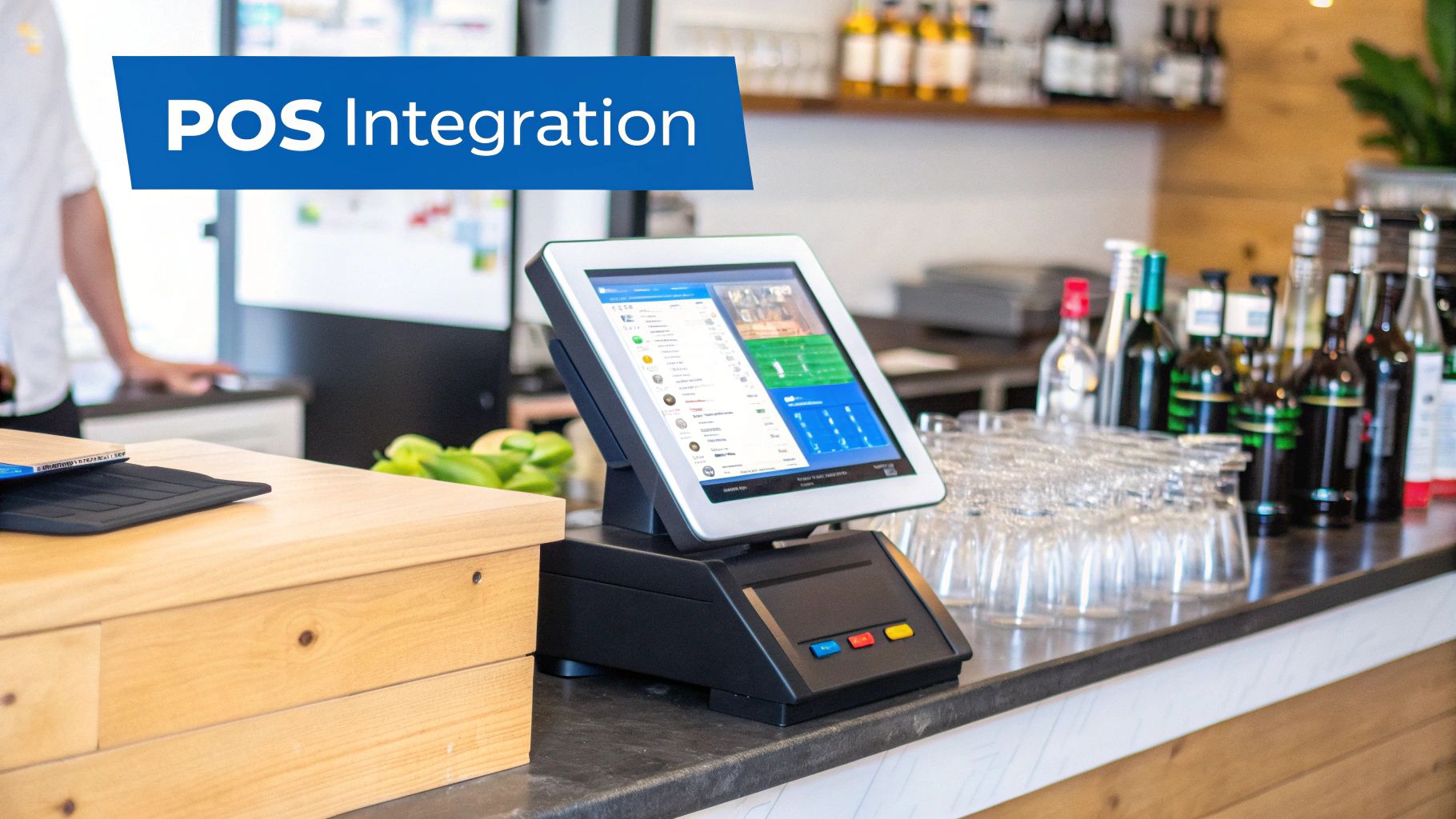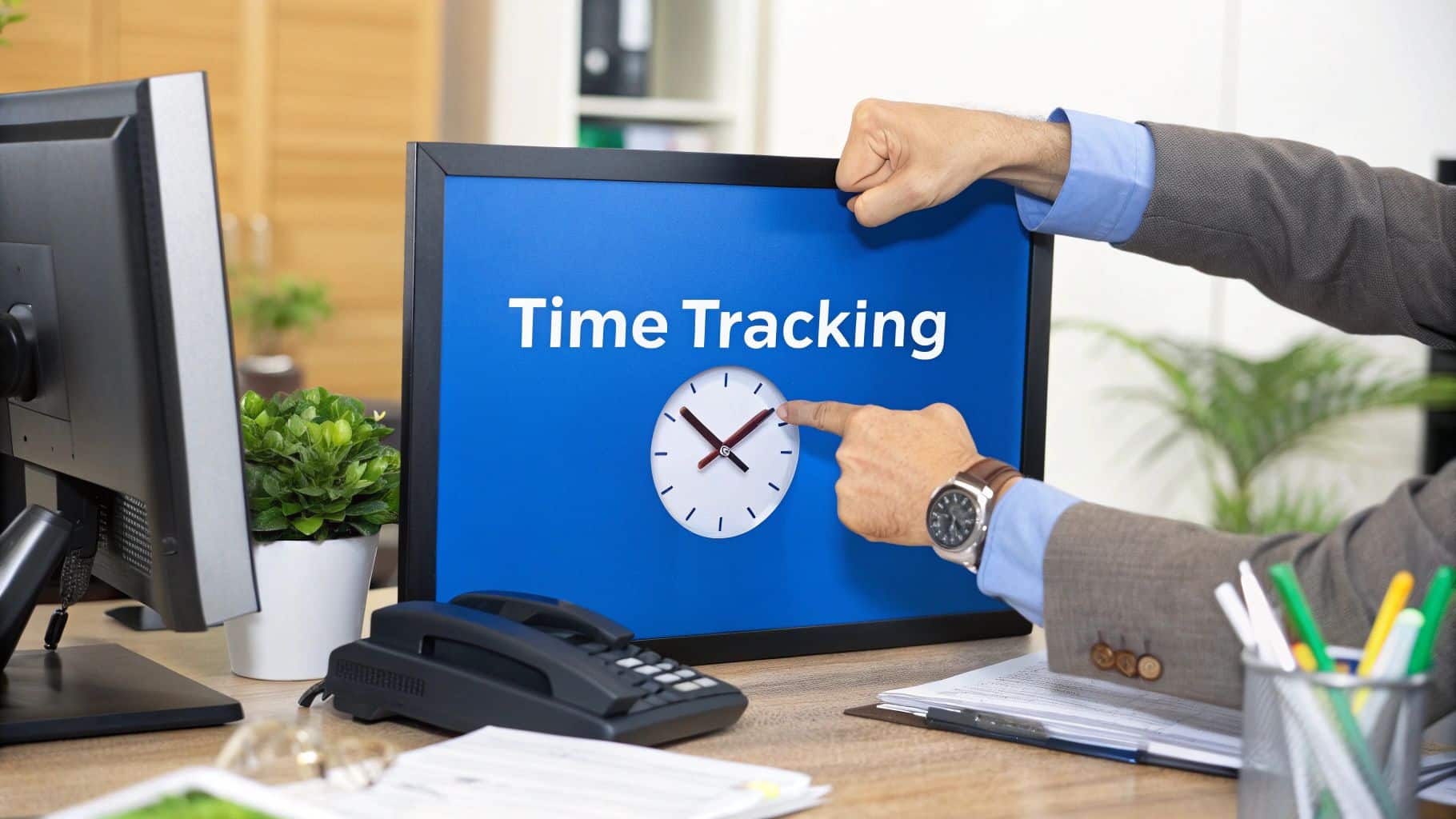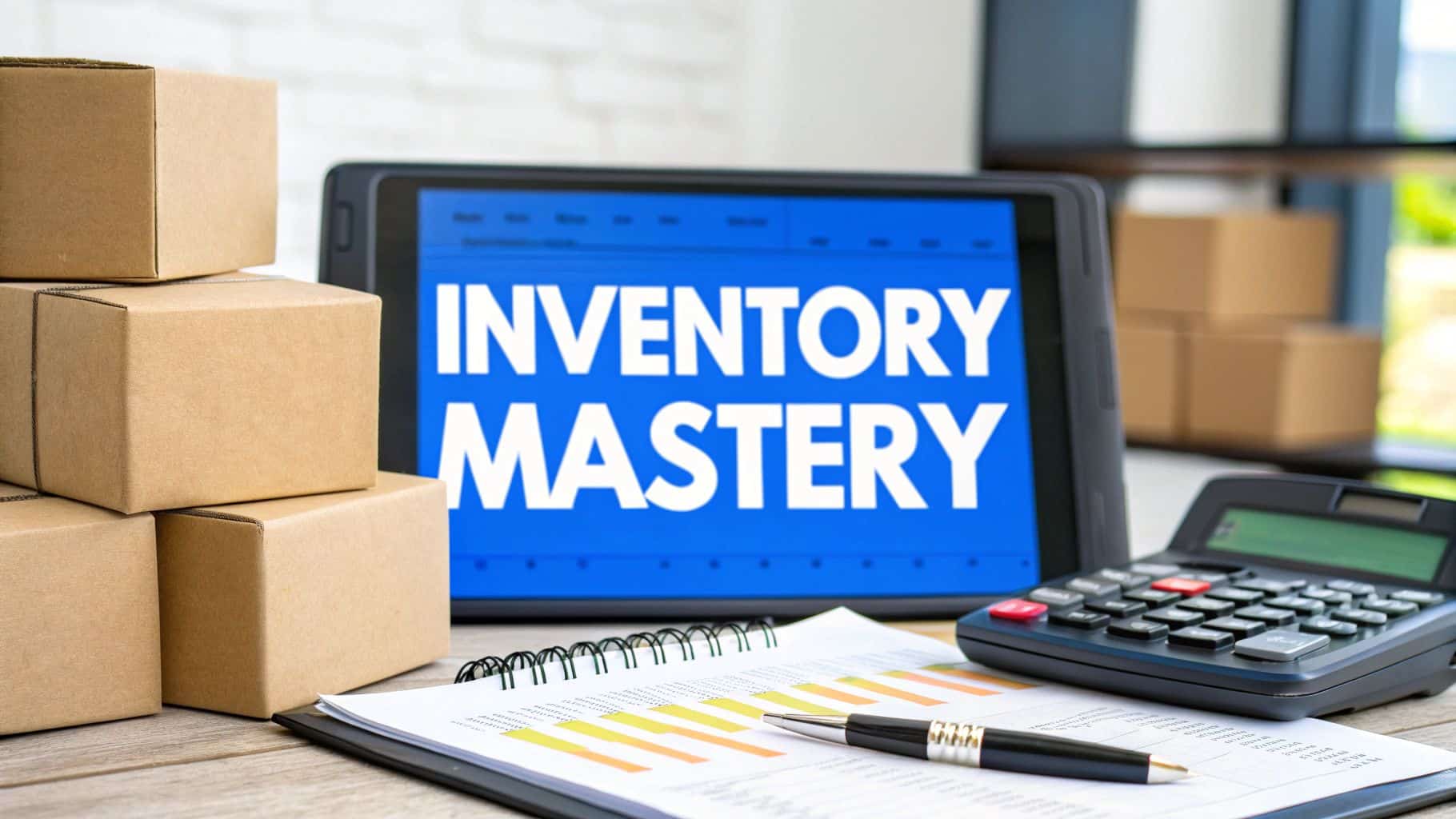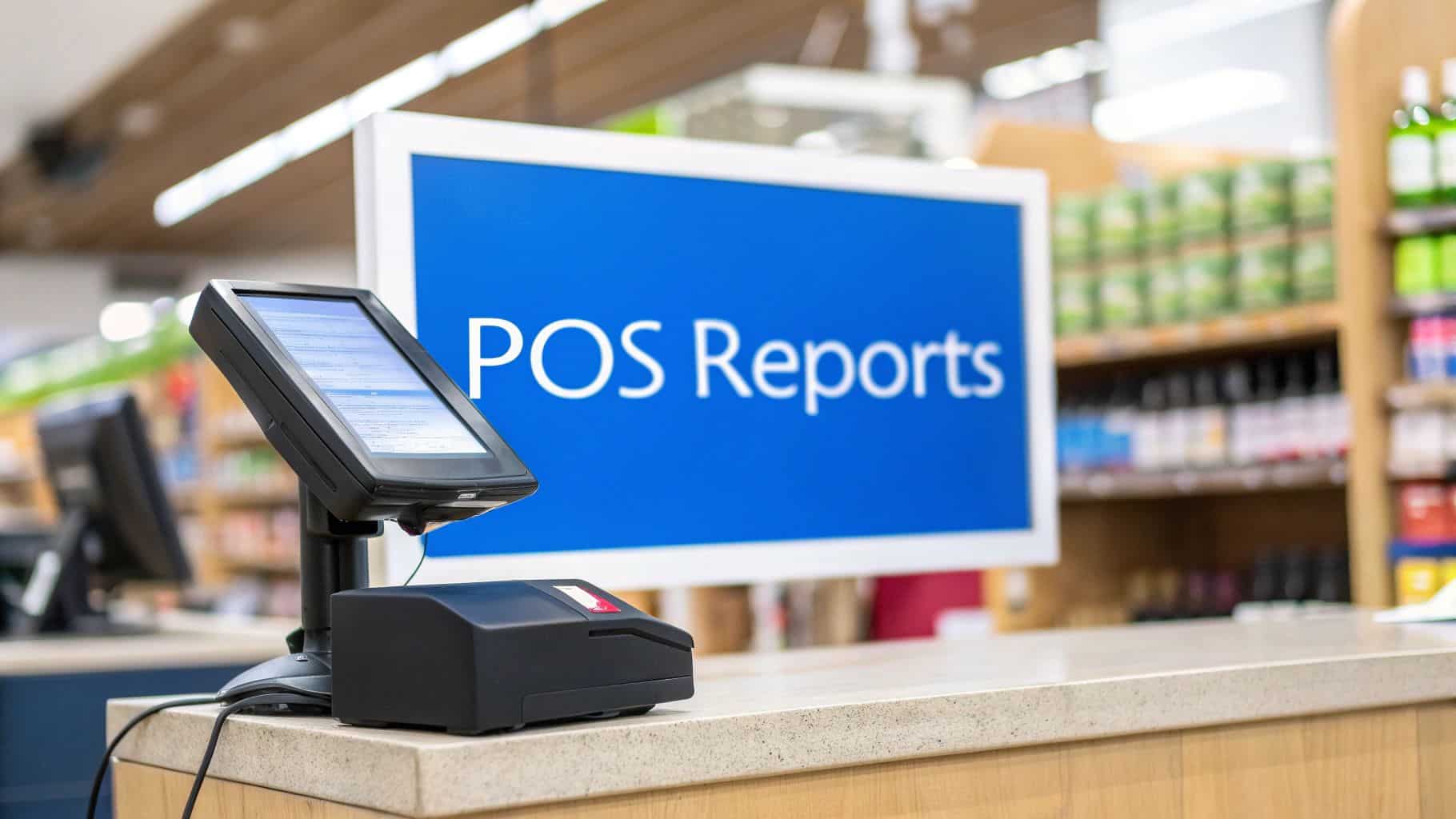Let's be honest, nobody gets into the bar business because they love counting bottles. But that tedious, end-of-week clipboard count? It's costing you more than just time—it’s silently draining your profits. A specialized bar inventory management system is the tool designed to stop the bleeding.
Think of it less as a digital spreadsheet and more as a command center for your entire beverage program. These platforms are built to track every drop of liquor, beer, wine, and mixer, moving way beyond a simple stock list. By connecting directly to your POS system, they automate tracking, slash waste, and plug the profit leaks that come from over-pouring, spills, and theft. You get a live, up-to-the-minute view of your most valuable assets.
Why Manual Counts Are Costing You Money
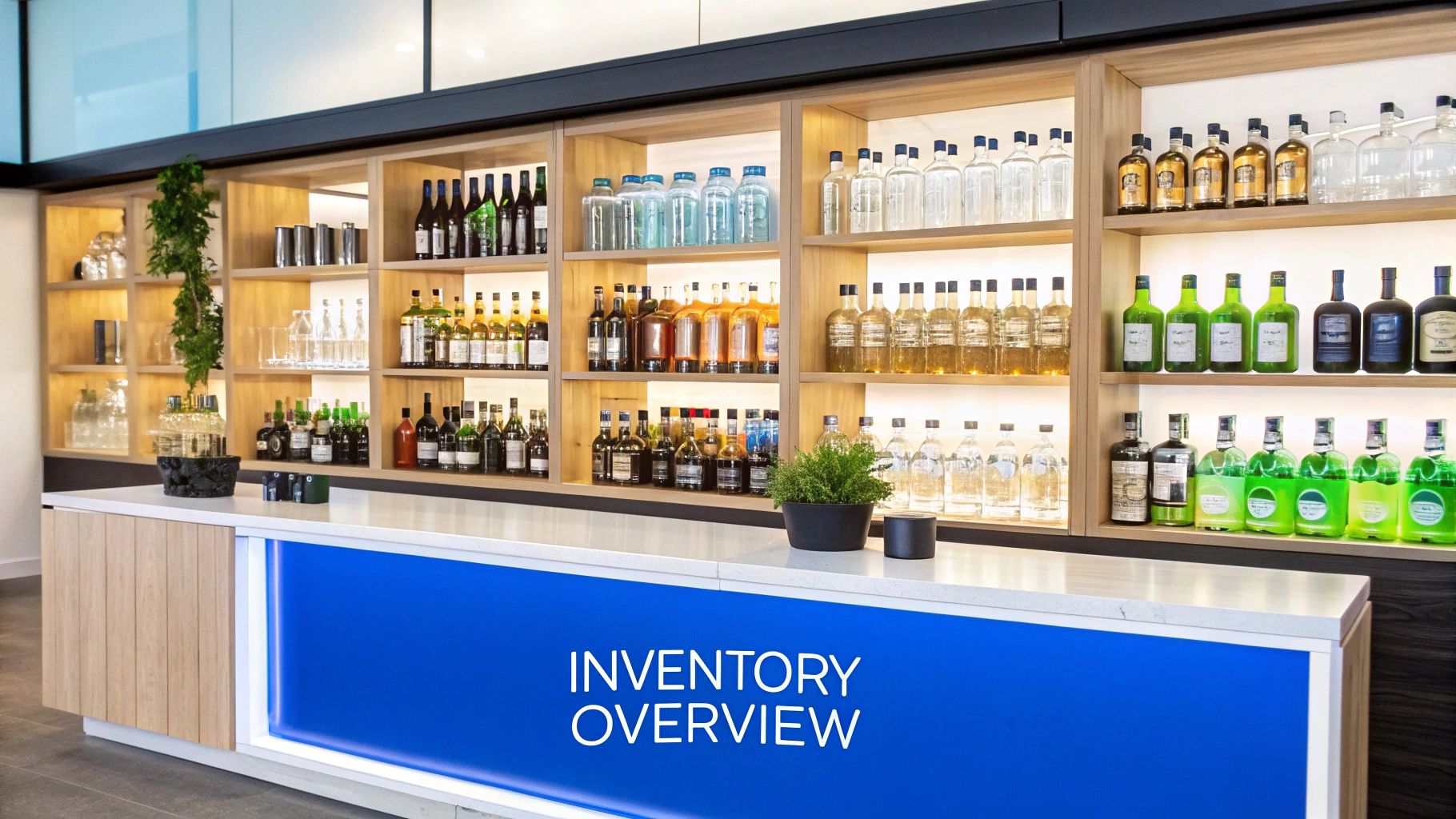
Staring at a wall of liquor bottles with a clipboard in hand feels archaic because, well, it is. This grueling task isn't just a drag for your staff; it’s a massive financial liability. Manual inventory is notoriously prone to human error, which snowballs into inaccurate stock levels and, ultimately, bad ordering decisions.
The traditional method gives you a snapshot of your inventory that’s already out of date. By the time you’ve finished counting and plugging numbers into a spreadsheet, your bar has already sold dozens more drinks. This lag makes it impossible to catch critical issues like a heavy-handed bartender or theft as they happen. The result? The average bar loses a shocking 20-25% of its inventory to these preventable problems. That’s a leak that goes straight to your bottom line.
The Shift to a Data-Driven Strategy
Smart bar owners are trading in their spreadsheets for a much more precise, automated approach. A dedicated bar inventory management system turns a chaotic chore into a powerful, data-driven strategy for growth.
This technology gives you a crystal-clear picture of what's really happening behind your bar. You stop guessing and start getting real, actionable insights. For a deeper dive into how these platforms work across industries, you can explore more about what inventory management software is and the ways it helps businesses get a grip on their stock.
The core benefit is shifting from reactive problem-solving to proactive management. You stop wondering where your profits are going and start using data to prevent losses before they even happen.
How Automation Maximizes Profitability
The real magic happens when these systems integrate with your other tools, especially your Point of Sale (POS) system. It’s a game-changer.
- Real-Time Deductions: Every time a bartender rings up a "Whiskey Sour," the system automatically deducts the exact amount of whiskey, lemon juice, and simple syrup from your inventory count. No guesswork.
- Accurate Variance Reporting: At the end of the shift, you can instantly see the difference between what was sold and what was poured. This variance report flags discrepancies immediately, pointing you toward training issues or potential theft.
- Smarter Ordering: The software tracks how fast you’re selling each product and suggests exactly what to order and when. This prevents you from tying up cash in slow-moving bottles or, even worse, running out of a crowd favorite on a busy Friday night.
By putting these crucial tasks on autopilot, you gain the fine-tuned control needed to squeeze every last drop of profit out of your beverage program.
What Really Makes Modern Inventory Software Tick?
If you want to understand what a modern bar inventory management system can do for your business, you have to look under the hood. These aren't just fancy spreadsheets; they're packed with specific tools designed to solve the most expensive problems bars face when they're stuck doing things by hand.
Think of it like this: a manual count is a single, blurry snapshot of your stock from last Tuesday. A modern system, on the other hand, is a live, high-definition video feed of your entire beverage program. That live view is all thanks to a handful of core features working together.
Real-Time Tracking and POS Integration
The absolute foundation of any good system is its ability to talk directly to your Point of Sale (POS) terminal. This is the secret sauce that gets rid of all the guesswork and human error that comes with manual counts. When your bartender rings up a margarita, the software instantly subtracts the exact amounts of tequila, triple sec, and lime juice from your inventory.
This seamless connection means you always know precisely what’s on your shelves. You're not waiting until Saturday night to realize you're almost out of your best-selling bourbon. You can see it coming a mile away and prevent a stockout before it costs you sales.
The image below breaks down the common headaches that these features are built to cure, showing just how much things like inaccurate counts and endless audits hurt a bar's bottom line.
As you can see, most of the big struggles in bar management come from not having good, timely data. That’s the exact problem modern software is designed to fix.
Automated Ordering and Recipe Costing
A great system doesn't just track what you have; it helps you figure out what you need. Automated ordering takes your sales data and your "par levels" (the minimum stock you want for any item) and generates smart purchase orders for you. This stops you from sinking cash into bottles that just sit there and makes sure you never run out of the essentials.
Another game-changer is recipe costing. This feature is huge. You enter the exact recipe for every drink on your menu, and the system calculates the precise cost down to the cent. This is how you make sure your menu prices are actually making you money.
By knowing the exact cost per pour, you can strategically price your cocktails to protect your margins, turning every sale into a predictable profit.
Bar inventory management has come a long way. The best platforms combine deep POS integration with automated ordering to slash waste and theft. They can lock in standard recipes, keep an eye on pour sizes, and even help you adjust prices based on real data. You can learn more about the impact of modern inventory software on bar profitability to see just how powerful these benefits can be.
Variance Reporting That Pinpoints Loss
This might just be the most valuable report you'll ever see. A variance report compares what your POS system says you sold with what your inventory count says you actually used. That gap—the "variance"—is where your profits are leaking out.
- Spotting Over-pouring: See a huge variance on your house vodka? A bartender is probably pouring with a heavy hand, a simple fix with a little training.
- Catching Theft: Are bottles of high-end whiskey disappearing with no sales to match? This report flags potential theft that you would have otherwise missed.
- Highlighting Waste: It also uncovers undocumented spills, mistakes, or comped drinks that were never recorded, giving you the full picture of your losses.
A solid inventory system is more than just a tool for counting bottles. It's a strategic weapon that turns a tedious chore into a powerhouse of data, giving you everything you need to run a tighter, more profitable bar.
To give you a clearer picture, here’s a breakdown of the must-have features and why they matter so much.
Essential Features of Bar Inventory Management Systems
| Feature | Description | Key Benefit |
|---|---|---|
| POS Integration | Syncs sales data directly from your point-of-sale system in real-time. | Eliminates manual data entry, reduces human error, and provides an instant, accurate view of stock levels. |
| Real-Time Tracking | Automatically deducts ingredients from inventory the moment a drink is sold. | Prevents stockouts of popular items and provides up-to-the-minute data for better decision-making. |
| Recipe Costing | Calculates the exact cost of every ingredient in a cocktail or dish. | Ensures every menu item is priced for profitability and helps identify low-margin drinks. |
| Automated Ordering | Generates purchase orders based on sales trends and preset par levels. | Avoids overstocking, prevents running out of key ingredients, and frees up cash flow. |
| Variance Reporting | Compares product sold vs. product used to identify discrepancies (loss). | Pinpoints sources of loss like over-pouring, waste, or theft, allowing you to take corrective action. |
| Supplier Management | Stores supplier information, pricing, and order history in one central location. | Streamlines the purchasing process and makes it easy to compare pricing and track order accuracy. |
Each of these features tackles a different piece of the puzzle, but together they provide a complete command center for your entire beverage operation.
The Real-World Impact on Your Bottom Line
The features of a bar inventory management system can sound a bit abstract, but their real value is measured in cold, hard cash. These platforms are designed to turn software capabilities into tangible profit, fundamentally reshaping your bar's financial health. It’s not just about saving a few minutes on counts; it's about making your entire operation more profitable.
The most immediate impact you'll see is a sharp drop in beverage costs. Precise, real-time tracking gives you a crystal-clear view of where every ounce of liquor is going. This kind of accuracy helps bars slash beverage costs by an average of 2-8%, a figure that goes straight to your bottom line with every drink you sell.
Reclaiming Time and Boosting Service
Picture your manager or lead bartender huddled in the storeroom with a clipboard for hours on end. Automating the inventory process hands all that time back to them.
Instead of counting bottles, your most valuable team members can get back on the floor, focusing on what actually drives revenue. They can be training new staff, enhancing the guest experience, or crafting a killer new cocktail menu. This shift transforms a tedious administrative chore into a revenue-generating opportunity.
This technology stops being an expense and becomes an investment in profitability. The return isn't just in saved liquor costs but in optimized labor and smarter business decisions that grow your revenue.
This newfound efficiency also helps you spot hidden trends you might have missed otherwise. For a deeper look at how these systems can cut waste and boost profits, check out this guide on mastering bar inventory management systems.
Making Smarter Purchasing Decisions
A great bar inventory system does more than just count what's on the shelf—it helps you predict what you'll need next. The detailed analytics and sales reports it generates are invaluable for making intelligent purchasing decisions.
- Preventing Overstock: You can instantly see which products are slow-movers, so you stop tying up cash in bottles that just sit there collecting dust.
- Eliminating Stockouts: The system alerts you when your best-sellers are running low, ensuring you never have to 86 a popular drink on a packed Saturday night.
- Identifying Menu Winners: Data-driven reports pinpoint your most profitable cocktails, allowing you to fine-tune your menu and promote high-margin items.
Using this data lets you align your ordering with actual customer demand. Better ordering is a cornerstone of financial control, and you can learn more about various approaches with these powerful inventory forecasting techniques. This insight ensures your capital is always working for you, invested in the products that bring in the most profit.
How to Choose the Right System for Your Bar
Picking the right bar inventory management system can feel like a huge task, but it doesn't have to be. The secret is to start by looking at your own bar first, not at a long list of software features. The needs of a high-volume nightclub are completely different from those of a cozy wine bar, so your first job is to pinpoint your biggest headaches.
Are you constantly 86-ing your most popular tequila on a slammed Saturday night? Is your pour cost creeping up for no good reason, hinting at over-pouring or theft? Before you even think about booking a demo, write down the top three problems you absolutely need this software to fix. This simple list will be your guide, ensuring you find a system that actually solves problems instead of just adding complexity.
Assess Your Bar's Unique Needs
Once you've identified your pain points, you can start matching them to what different systems offer. A platform that's perfect for a single-location pub might completely fall apart trying to manage a multi-venue operation. For example, when choosing an inventory system, it’s critical to think about tracking unique items like draft beer sitting in specialized keg coolers.
Here are a few questions to get you started:
- Size and Complexity: Are you a small, independent bar or a growing brand with multiple locations? You need a system that can grow with you, not one you'll have to ditch in two years.
- Ease of Use: Let's be honest—how comfortable is your team with new tech? A clunky, confusing interface is a recipe for disaster. If your bartenders and managers don't use it, you've wasted your money. The best systems feel intuitive right from the start.
- Integration Capabilities: Your inventory software has to talk to your other tools, especially your POS and accounting software. If it can't, you're just creating more manual data entry for yourself, which is the exact opposite of what you want.
Understanding Pricing and Total Cost
The industry has moved almost entirely to cloud-based subscription models, which is great news for bars of all sizes. It means more flexibility and less upfront cost. Pricing is all over the map; you might see basic plans starting around $25 per month, while more powerful systems built for multiple locations and deep analytics can run anywhere from $200 to over $1,000 monthly.
The huge advantage of these cloud systems is that you don't need to buy and maintain expensive on-site servers, which could easily set you back $10,000 to $50,000 just to get started. If you want a deeper dive into the numbers, you can learn more about the costs of inventory management software.
Your goal is to find a strategic partner, not just a piece of software. Pay close attention to the quality of customer support and the onboarding process during your demos. A great product with poor support can quickly become a major headache.
Getting Your New System Up and Running for Maximum Impact
Picking the right bar inventory management system is a huge first step, but the real win comes from weaving it into the very fabric of your bar's operations. A great implementation isn't about just flipping a switch on new software. It's about having a solid plan for setting up your data, training your crew, and building new habits that stick.
Think of the initial setup as pouring the foundation for a new building. This is where you get everything right from the start. You'll need to input your opening inventory with painstaking accuracy—every bottle, every keg, every garnish. This is also your chance to digitize your cocktail recipes to track every single pour and to get all your supplier pricing and details loaded in. Nailing this initial data entry is non-negotiable; it’s the only way to ensure the reports and analytics you get later are worth their salt.
Getting Your Team On Board
Let's be honest: one of the biggest roadblocks you'll face is getting your staff to buy in. It's easy for a new system to feel like a "Big Brother" tool designed to micromanage them. The secret is to position it as something that makes their lives easier, not a tool for surveillance.
Walk them through how it gets rid of those soul-crushing, late-night manual counts and makes ordering a breeze. When your bartenders see that precise tracking protects the bar’s profits—which directly impacts their job security and tips—they’ll start to see the light. Make sure your training sessions hammer home these benefits, not just the technical how-tos.
The real objective is to make the system part of your bar's culture. It shouldn't feel like an extra chore, but a normal part of the day. When the team views it as a tool that helps everyone succeed, you've won the battle for adoption.
Building New Routines and Workflows
To truly get your money's worth, the system needs to be at the heart of your daily operations. This means creating new, consistent routines until they become second nature. A simple daily or weekly checklist can work wonders here, making sure nothing gets missed in the shuffle. While every bar is different, a solid approach to a restaurant inventory management system always includes a few core practices.
Here are a few essential habits to build from day one:
-
Checking In Deliveries: Every time a new order arrives, it needs to be immediately cross-referenced with the purchase order and logged in the system. This ensures your stock levels are accurate from the second those boxes hit the door.
-
Running Spot-Checks: Don't wait for the big weekly count. Get in the habit of doing quick counts on a few of your high-value, fast-moving bottles. It keeps everyone accountable and helps you catch small issues before they blow up.
-
Diving Into Variance Reports: Make reviewing variance reports a non-negotiable weekly task for management. These reports are a goldmine of information, pointing you toward potential over-pouring, training gaps, or even theft.
What's Next for Bar Management Tech?
The world of bar inventory management is moving fast. We're shifting from simply counting bottles to building systems that are shockingly good at predicting the future. The next big thing? It’s all about artificial intelligence (AI) and machine learning, and it’s completely changing the game for how bars operate.
Think about a system that doesn't just track what you have, but tells you what you’ll need next week. That's where we're headed. AI-powered platforms are starting to chew through your past sales data, local event calendars, weather forecasts, and even social media chatter to see what’s coming.
Your software could soon predict a run on Aperol spritzes during a sunny spell or give you a heads-up to order more whiskey before a cold front rolls in. It’s all about being prepared before the rush even starts.
The Power of Looking Ahead
This move toward predictive analytics isn't just a neat trick; it's a real strategic weapon. When you can accurately guess what your customers are going to order, you can fine-tune your purchasing like never before. The impact is huge:
- Less Overstock: You won't have cash tied up in bottles that just sit on the shelf.
- No More 86'ing: You'll never have to tell a customer you're out of their favorite drink again.
- Drastically Reduced Waste: This is a lifesaver for perishables like craft beer kegs and fresh juice.
Adopting this kind of tech isn't just about being modern. It’s about gaining a serious competitive advantage in a market where data is king. For any beverage business looking to grow, this is a smart, forward-thinking move.
This evolution is already making waves globally. The market for brewery and bar inventory software is booming. Brewery-specific software alone was valued at over USD 7.86 billion in 2025, and it’s expected to explode to USD 20.76 billion by 2035.
That’s a compound annual growth rate of about 10.2%, driven by bars and breweries scrambling to get a handle on their operations and stay ahead of the curve. You can read more about these brewery inventory market trends to see just how quickly the industry is changing.
Got Questions? We've Got Answers
Jumping into a new inventory system for your bar is a big decision, and it’s totally normal to have a few questions swirling around. Let's tackle some of the most common ones we hear from bar owners and managers to clear things up.
Think of this as a quick chat over the bar—straight answers, no fluff.
How Long Does It Take to Actually Get This Set Up?
This is probably the biggest question on everyone's mind. The good news is, you're not looking at weeks of downtime. Most bars can get a new system up and running in just a few days, maybe a week at most.
The heaviest lift is right at the beginning: getting all your products, cocktail specs, and vendor details into the system. But here’s the thing—modern platforms are built for this. Most come with simple import tools (like using a spreadsheet) and hands-on support from their team to make sure you get started on the right foot, fast.
Is My Staff Going to Hate This?
Let’s be honest, nobody likes change just for the sake of it. You’ll probably get a little pushback at first, and that's okay. The trick is to show your team how this new tool makes their lives easier, not harder.
It's not about watching their every move; it's about eliminating the soul-crushing, late-night manual counts. When you frame it that way—and explain how a more profitable bar means better job security and tips for everyone—you'll see them get on board.
Focus the training on the "what's in it for me" angle. Once your bartenders realize they can ditch the clipboard and stop guessing at counts, they'll wonder how they ever did it the old way.
Can a Small, Independent Bar Actually Afford This?
Yes, absolutely. The old days of needing a five-figure check just for the hardware and software are long gone. Thanks to cloud-based systems, this kind of powerful tech is well within reach for just about any bar.
Most are sold as a subscription, so you pay a manageable monthly fee instead of a massive upfront cost. The pricing usually scales with your business, so you're not paying for features you don't need. It’s a smart investment that pays for itself pretty quickly.
Ready to see how an all-in-one solution can boost your bar's bottom line? Biyo POS builds powerful inventory management right into your point-of-sale, giving you the control and insights you need to thrive. Start your free trial today!

